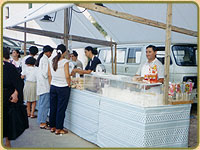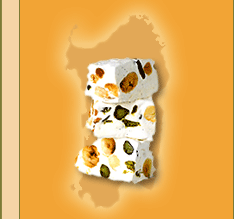All of the rural feasts on the island include torrone-makers (turronargios), whose counters are loaded with large blocks of this delicious nougat.
Until just a few years ago, torrone was mostly made at home on a small scale, where the ingredients would be mixed in a copper pot (su cheddargiu) over a brick oven (forredda). Plenty of elbow grease and patience were required to make the torrone, since the honey had to be melted over a low heat and then baked, before the egg whites were added and the mixture beaten until foamy (a process that would take hours on end). Once cooked, the toasted almonds or other nuts were added, and then the finished torrone was placed into wooden drawers lined with greaseproof paper. After cooling down, the torrone was ready to be sold in small chunks all over the island.
 The production of torrone started in a place called Barbagia, in the very heart of Sardinia, where the ingredients – walnuts, hazelnuts and almonds – grow in abundance. In 1910, Maurizio Floris left his small woodland hamlet, called Tonara, to sell the sweet delicacy at feasts and festivals throughout Sardinia. Working, to begin with, from a base in Villanova Monteleone, in 1945 came the definitive transfer to Alghero, where Maurizio set up his first torrone production facility, purchasing modern machinery including an electric toaster. The family tradition has been perpetuated by Maurizio’s son, Antonio, who continues to make torrone in accordance with the original recipe using finest-quality ingredients.
The production of torrone started in a place called Barbagia, in the very heart of Sardinia, where the ingredients – walnuts, hazelnuts and almonds – grow in abundance. In 1910, Maurizio Floris left his small woodland hamlet, called Tonara, to sell the sweet delicacy at feasts and festivals throughout Sardinia. Working, to begin with, from a base in Villanova Monteleone, in 1945 came the definitive transfer to Alghero, where Maurizio set up his first torrone production facility, purchasing modern machinery including an electric toaster. The family tradition has been perpetuated by Maurizio’s son, Antonio, who continues to make torrone in accordance with the original recipe using finest-quality ingredients.





